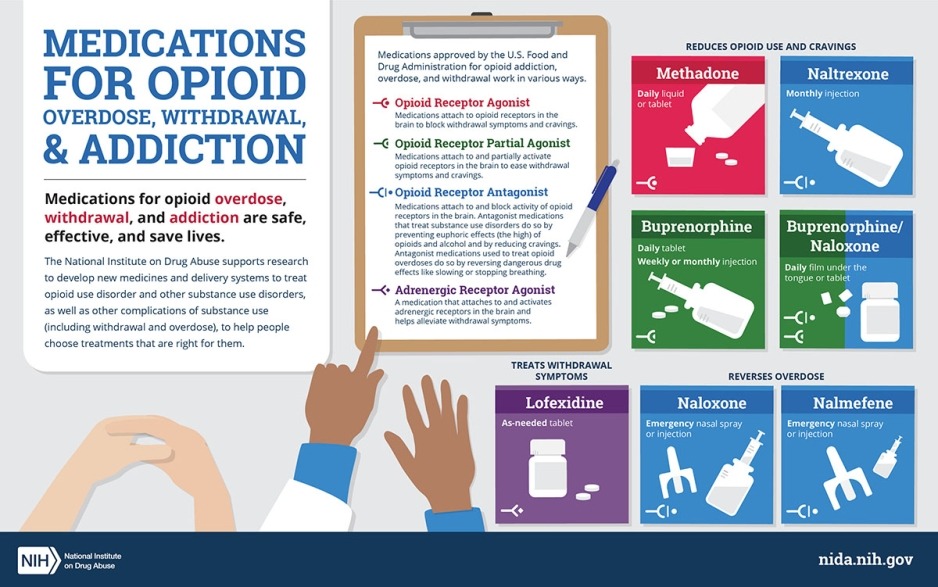Medications for Opioid Use Disorder (MOUD) Infographic
This infographic shows different types of medications approved by the U.S. Food and Drug Administration for opioid overdose, withdrawal, and addiction. This infographic is intended to present basic information on common medications and formulations available to consumers. For comprehensive information on all available medications for patients and health professionals, please visit the FDA's webpages on medications for opioid use disorders and opioid overdose reversal medications. Additional information on medications for substance use disorders is available from the U.S. Substance Abuse and Mental Health Services Administration.
Medications for opioid overdose, withdrawal, and addiction
Medications for opioid overdose, withdrawal, and addiction are safe, effective, and save lives.
The National Institute on Drug Abuse supports research to develop new medicines and delivery systems to treat opioid use disorder and other substance use disorders, as well as other complications of substance use (including withdrawal and overdose), to help people choose treatments that are right for them.
Medications approved by the U.S. Food and Drug Administration for opioid addiction, overdose, and withdrawal work in various ways.
- Opioid Receptor Agonist: Medications attach to and activate opioid receptors in the brain to block withdrawal symptoms and cravings.
- Opioid Receptor Partial Agonist: Medications attach to and partially activate opioid receptors in the brain to ease withdrawal symptoms and cravings.
- Opioid Receptor Antagonist: Medications attach to and block activity of opioid receptors in the brain. Antagonist medications that treat substance use disorders do so by preventing euphoric effects (the high) of opioids and alcohol and by reducing cravings. Antagonist medications used to treat opioid overdoses do so by reversing dangerous drug effects like slowing or stopping breathing.
- Adrenergic Receptor Agonist: A medication that attaches to and activates adrenergic receptors in the brain and helps alleviate withdrawal symptoms.
Four cards show medications prescribed to reduce opioid use and cravings.
- Methadone is available in daily liquid or tablets.
- Naltrexone is available in a monthly injection.
- Buprenorphine available in daily tablet and weekly or monthly injection.
- Buprenorphine/naloxone is available in daily film that dissolves under the tongue or tablet.
One card shows medication prescribed to treat withdrawal symptoms.
- Lofexidine is available as a tablet taken as needed.
Two cards show medication used to reverse overdose.
- Naloxone is available as an emergency nasal spray or injection.
- Nalmefene is available as an emergency nasal spray or injection.
This publication is available for your use and may be reproduced in its entirety without permission from NIDA. Citation of the source is appreciated, using the following language: Source: National Institute on Drug Abuse; National Institutes of Health; U.S. Department of Health and Human Services.

